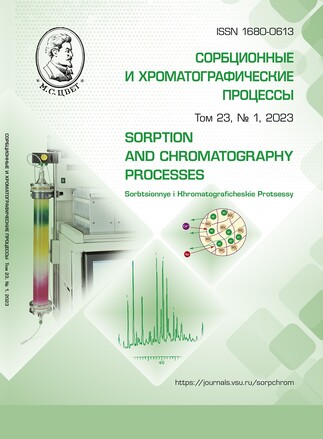Сорбция ноотропов из водных сред активным углем Norit® PK 1-3
Аннотация
В последнее время возрастают количество фармацевтических отходов, загрязненность поверхностных и грунтовых вод лекарственными препаратами и, как следствие, увеличивается токсикологический риск для живых организмов. Активные угли являются распространенными сорбентами для извлечения из вод загрязнителей различного происхождения, в том числе органических.
С применением активного угля торговой марки Norit PK 1-3, получаемого на основе торфа, изучена сорбция нооторопов (НТ) – фармакологической группы корректоров нарушений мозгового кровообращения, синтетического и природного происхождения – винпоцетина (ВП), циннаризина (ЦН), гамма-аминомасляной (ГАМК) и никотиновой (НК) кислот.
При массе сорбента 0.10 г, объеме раствора 100 см3, времени контакта фаз – 1 ч степень извлечения НТ составляет 52-95%, предельная сорбция – 7.8-72.5 мг/г. Степень извлечения зависит от рН и для НК она максимальна в интервале от 5 до 11, ВП и ЦН от 7 до 13. ГАМК максимально извлекается при рН 7. Влияние рН на эффективность извлечения обусловлено притяжением противоположных зарядов между поверхностью сорбента и диссоциированной формой НТ. Кинетика сорбции описывается моделью псевдо-второго порядка, изотермы сорбции (I тип) – моделью Ленгмюра.
Установлено, что сорбция зависит от природы сорбата – кислотности, параметра гидрофобности, площади полярной поверхности молекулы, содержания различных форм сорбата в растворе [рассчитаны с помощью программы MarvinSketch вер. 22.6 (Chemaxon)] и заряда поверхности сорбента. Для НТ помимо гидрофобных взаимодействий характерны, π-стэкинг и диполь-дипольные взаимодействия.
Скачивания
Литература
Gupta R., Sati B., Gupta A. Treatment and recycling of wastewater from pharmaceutical industry. Advances in biological treatment of industrial waste water and their recycling for a sustainable future. ap-plied environmental science and engineer-ing for a sustainable future. Springer, Singapore. 2019: 267-302. https://doi.org/10.1007/978-981-13-1468-1_9
Riva F., Castiglioni S., Fattore E., Manenti A., Davoli E., Zuccato E. Monitor-ing emerging contaminants in the drinking water of Milan and assessment of the hu-man risk, Int. J. Hyg. Environ. Health. 2018; 221: 451-457. https://doi.org/10.1016/j.ijheh.2018.01.008
Gadipelly C., Pérez-González A., Yadav G., Ortiz I., Ibáñez R., Rathod V., Marathe K., Pharmaceutical industry wastewater: review of the technologies for water treatment and reuse, Ind. Eng. Chem. Res., 2014; 53: 11571-11592. https://doi.org/10.1021/ie501210j
Kushnir A.A., Sukhanov P.T., Sizo K.O., Determination of nootropics in medicines, biological objects and food additives (review), Vestnik Voronezhskogo gosudarstvennogo universiteta. Seriya: Khimiya. Biologiya. Farmatsiya. 2021; 1: 5-19. (In Russ.)
Postigo C., Richardson S.D. Trans-formation of pharmaceuticals during oxidation/disinfection processes in drinking water treatment. J. Hazard. Mater. 2014; 279: 461-475. https://doi.org/10.1016/j.jhazmat.2014.07.029
Bingbing Q., Qianni S., Jicheng S., Chenhao Y., Huaqiang C., Application of biochar for the adsorption of organic pollutants from wastewater: Modification strategies, mechanisms and challenges. Sep. Purif. Technol. 2022; 300: 121925. https://doi.org/10.1016/j.seppur.2022.121925
Gęca M., Wiśniewska M., Nowicki P., Biochars and activated carbons as adsorbents of inorganic and organic compounds from multicomponent systems – A review, Adv. Colloid Interface Sci., 2022; 305: 102687. https://doi.org/10.1016/j.cis.2022.102687
El-Sayed Y., Bandosz T.J., Effect of Increased basicity of activated carbon sur-face on valeric acid adsorption from aqueous solution activated carbon. Phys. Chem. Chem. Phys. 2003; 5: 4892-4898. https://doi.org/10.1039/B306983B
Lladó J., Solé-Sardans M., Lao-Luque C., Fuente E., Ruiz B. Removal of pharmaceutical industry pollutants by coal-based activated carbons, Process Saf. Envi-ron. Prot. 2016; 104: 294-303. https://doi.org/10.1016/j.psep.2016.09.009
Alves C.C., Franca A.S., Oliveira L.S., Removal of phenylalanine from aqueous solutions with thermo-chemically mod-ified corn cobs as adsorbents. LWT-Food Science and Technology. 2013; 51(1): 1-8. https://doi.org/10.1016/j.lwt.2012.11.012
Doulia D., Rigas F., Gimouhopoulos C., Removal of amino acids from water by adsorption on polystyrene resins, J. Chem. Technol. Biotechnol., 2013; 76(1): 83-89. https://doi.org/10.1002/1097-4660(200101)76:1<83::AID-JCTB345>3.0.CO;2-N
Kushnir A.A., Sukhanov P.T., Savvina A.G., Bondareva L.P., Churilina E.V., Poluzhenkova E.V., Shatalov G.V., Sorp-tion of aromatic acids from aqueous solutions by polymer based on N-vinylpyrrolidone, Russ. J. Appl. Chem., 2016; 89: 891-896. https://doi.org/10.1134/S1070427216060070
Lim A., Chew J.J., Ngu L.H., Ismadji S., Khaerudini D.S., Sunarso J., Synthesis, characterization, adsorption iso-therm, and kinetic study of oil palm trunk-derived activated carbon for tannin removal from aqueous solution. ACS omega. 2020; 5(44): 28673-28683. https://doi.org/10.1021/acsomega.0c03811
Mojoudi N., Mirghaffari N., So-leimani M., Shariatmadari H., Belver C., Bedia J., Phenol adsorption on high microporous activated carbons prepared from oily sludge: equilibrium, kinetic and thermodynamic studies, Scientific Reports, 2019; 9(1): 19352. https://doi.org/10.1038/s41598-019-55794-4
Sviridova E.S., Voronyuk I.V., Eliseeva T.V., Selemenev V.F., Mukhin V.M. Comparison of the sorption of 4-hydroxybenzaldehyde by activated carbon of different grades under static conditions. Sorbtsionnye i khromatograficheskie protsessy. 2022; 22(1): 50-57. (In Russ.) https://doi.org/10.17308/sorpchrom.2022.22/9020
Egunova O.R., Shtykov S.N. Con-centration of some antibiotics of the fluoroquinolone series by magnetic solid-phase extraction on magnetite nanoparticles, Sorbtsionnye i khromatograficheskie protsessy, 2018; 18(6): 825-835. (In Russ.). https://doi.org/10.17308/sorpchrom.2018.18/610
Namasivayam C., Senthilkumar S., Removal of Arsenic (V) from aqueous so-lution using industrial solid waste: adsorp-tion rates and equilibrium studies. Ind. Eng. Chem. Res. 1998; 37: 4816-4822.
Mohamed E.F., Andriantsiferana C., Wilhelm A.M., Delmas H., Competitive adsorption of phenolic compounds from aqueous solution using sludge-based acti-vated carbon, Environ. Technol., 2011; 32(12): 1325-1336. https://doi.org/10.1080/09593330.2010.536783








